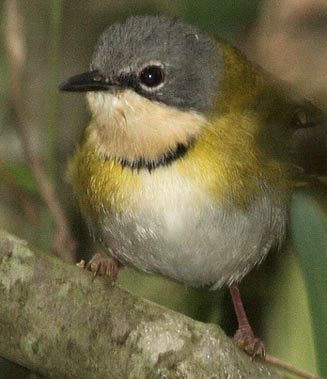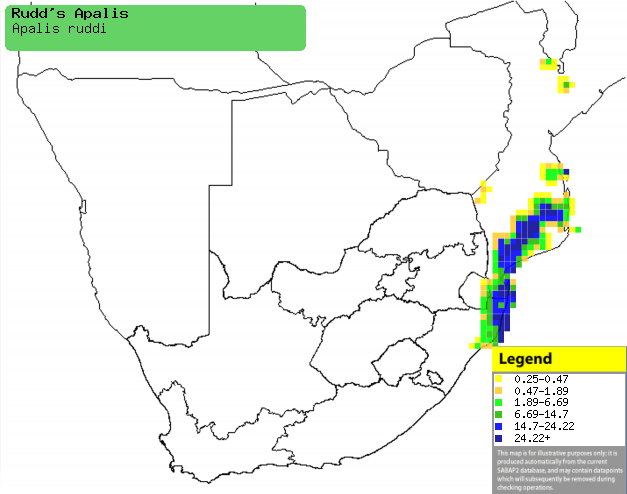|
Apalis ruddi (Rudd's apalis)
Ruddse kleinjantjie [Afrikaans]; Rudd-apalis [Dutch];
Apalis de Rudd [French]; Rudds feinsänger [German]; Apalis de Rudd [Portuguese]
Life
> Eukaryotes >
Opisthokonta
> Metazoa (animals) >
Bilateria >
Deuterostomia > Chordata >
Craniata > Vertebrata (vertebrates) > Gnathostomata (jawed
vertebrates) > Teleostomi (teleost fish) > Osteichthyes (bony fish) > Class:
Sarcopterygii (lobe-finned
fish) > Stegocephalia (terrestrial
vertebrates) > Tetrapoda
(four-legged vertebrates) > Reptiliomorpha > Amniota >
Reptilia (reptiles) >
Romeriida > Diapsida > Archosauromorpha > Archosauria >
Dinosauria
(dinosaurs) > Saurischia > Theropoda (bipedal predatory dinosaurs) >
Coelurosauria > Maniraptora > Aves
(birds) >
Order: Passeriformes > Family: Cisticolidae
> Genus: Apalis
 |
|
|
Rudd's apalis, Mkhuze Game Reserve, KwaZulu-Natal,
South Africa. [photo
Alan Manson
©] |
|
For information about this species, see
www.birdforum.net/opus/Rudd's_Apalis
Distribution and habitat
Endemic to southern Africa, with the bulk of its population
centered around southern Mozambique and eastern Kwazulu-Natal. Here it is
locally abundant in habitats with dense undergrowth, such Acacia and
mixed woodland.
|
 |
|
Distribution of Rudd's apalis in southern Africa,
based on statistical smoothing of the records from first SA Bird Atlas
Project (©
Animal Demography unit, University of
Cape Town; smoothing by Birgit Erni and Francesca Little). Colours range
from dark blue (most common) through to yellow (least common).
See here for the latest distribution
from the SABAP2. |
Food
It mainly eats small insects and larvae, foraging at all
levels of the forest, gleaning prey from leaves and twigs. It is commonly seen
in mixed-species foraging flocks, sometimes with
Yellow-breasted apalises.
Breeding
- The male solely builds the nest in about 8-12 days, consisting of an oval
ball with a side entrance, built of dried grass and other plant stems. It
also occasionally builds it entirely out of old-mans-beard-lichen (Usnea).
The outside is often covered with bits of green moss, and it is typically
attached with spider web to twigs in a tangled creeper, bush or tree.
- It lays 1-3 eggs, usually in the months from about September-November.
Threats
Not threatened internationally, but Near-threatened
in South Africa and Swaziland, although its range appears to have remained
unchanged since about 1970.
References
-
Hockey PAR, Dean WRJ and Ryan PG 2005. Roberts
- Birds of southern Africa, VIIth ed. The Trustees of the John Voelcker
Bird Book Fund, Cape Town.
|
